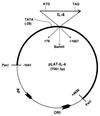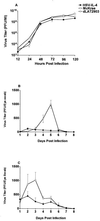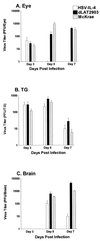Recombinant herpes simplex virus type 1 expressing murine interleukin-4 is less virulent than wild-type virus in mice
- PMID: 11533166
- PMCID: PMC114471
- DOI: 10.1128/JVI.75.19.9029-9036.2001
Recombinant herpes simplex virus type 1 expressing murine interleukin-4 is less virulent than wild-type virus in mice
Abstract
The effect of interleukin-4 (IL-4) on herpes simplex virus type 1 (HSV-1) infection in mice was evaluated by construction of a recombinant HSV-1 expressing the gene for murine IL-4 in place of the latency-associated transcript (LAT). The mutant virus (HSV-IL-4) expressed high levels of IL-4 in cultured cells. The replication of HSV-IL-4 in tissue culture and in trigeminal ganglia was similar to that of wild-type virus. In contrast, HSV-IL-4 appeared to replicate less well in mouse eyes and brains. Although BALB/c mice are highly susceptible to HSV-1 infection, ocular infection with HSV-IL-4 resulted in 100% survival. Furthermore, 57% of the mice survived coinfection with a mixture of HSV-IL-4 and a lethal dose of wild-type McKrae, compared with only 10% survival following infection with McKrae alone. Similar to wild-type BALB/c mice, 100% of IL-4(-/-) mice also survived HSV-IL-4 infection. T-cell depletion studies suggested that protection against HSV-IL-4 infection was mediated by a CD4(+)-T-cell response.
Figures





Similar articles
-
An M2 Rather than a TH2 Response Contributes to Better Protection against Latency Reactivation following Ocular Infection of Naive Mice with a Recombinant Herpes Simplex Virus 1 Expressing Murine Interleukin-4.J Virol. 2018 Apr 27;92(10):e00051-18. doi: 10.1128/JVI.00051-18. Print 2018 May 15. J Virol. 2018. PMID: 29491152 Free PMC article.
-
Infection of BALB/c mice with a herpes simplex virus type 1 recombinant virus expressing IFN-gamma driven by the LAT promoter.Virology. 2002 Oct 10;302(1):144-54. doi: 10.1006/viro.2002.1609. Virology. 2002. PMID: 12429523
-
The role of interleukin (IL)-2 and IL-4 in herpes simplex virus type 1 ocular replication and eye disease.J Infect Dis. 1999 May;179(5):1086-93. doi: 10.1086/314736. J Infect Dis. 1999. PMID: 10191208
-
Interleukin-12- and gamma interferon-dependent innate immunity are essential and sufficient for long-term survival of passively immunized mice infected with herpes simplex virus type 1.J Virol. 2001 Oct;75(20):9596-600. doi: 10.1128/JVI.75.20.9596-9600.2001. J Virol. 2001. PMID: 11559791 Free PMC article.
-
The latency-associated gene of herpes simplex virus type 1 (HSV-1) interferes with superinfection by HSV-1.J Neurovirol. 2002 Dec;8 Suppl 2:97-102. doi: 10.1080/13550280290167920. J Neurovirol. 2002. PMID: 12491159 Review.
Cited by
-
Optic neuritis in different strains of mice by a recombinant HSV-1 expressing murine interleukin-2.Invest Ophthalmol Vis Sci. 2009 Jul;50(7):3275-82. doi: 10.1167/iovs.08-3211. Epub 2009 Feb 21. Invest Ophthalmol Vis Sci. 2009. PMID: 19234357 Free PMC article.
-
Poxvirus interleukin-4 expression overcomes inherent resistance and vaccine-induced immunity: pathogenesis, prophylaxis, and antiviral therapy.Virology. 2011 Jan 20;409(2):328-37. doi: 10.1016/j.virol.2010.10.021. Epub 2010 Nov 10. Virology. 2011. PMID: 21071055 Free PMC article.
-
Type 2 Innate Lymphoid Cells Induce CNS Demyelination in an HSV-IL-2 Mouse Model of Multiple Sclerosis.iScience. 2020 Sep 10;23(10):101549. doi: 10.1016/j.isci.2020.101549. eCollection 2020 Oct 23. iScience. 2020. PMID: 33083718 Free PMC article.
-
Comparison of adjuvant efficacy of herpes simplex virus type 1 recombinant viruses expressing TH1 and TH2 cytokine genes.J Virol. 2003 May;77(10):5774-83. doi: 10.1128/jvi.77.10.5774-5783.2003. J Virol. 2003. PMID: 12719570 Free PMC article.
-
Protection against recurrent ocular herpes simplex virus type 1 disease after therapeutic vaccination of latently infected mice.J Virol. 2003 Jun;77(12):6692-9. doi: 10.1128/jvi.77.12.6692-6699.2003. J Virol. 2003. PMID: 12767989 Free PMC article.
References
-
- Abehsira-Amar O, Gibert M, Joliy M, Theze J, Jankovic D L. IL-4 plays a dominant role in the differential development of Tho into Th1 and Th2 cells. J Immunol. 1992;148:3820–3829. - PubMed
-
- Biron C A. Cytokines in the generation of immune responses to, and resolution of, virus infection. Curr Opin Immunol. 1994;6:530–538. - PubMed
-
- Cheers C, Janas M, Ramsay A, Ramshaw I. Use of recombinant viruses to deliver cytokines influencing the course of experimental bacterial infection. Immunol Cell Biol. 1999;77:324–330. - PubMed
-
- Cherwinski H M, Schumacher J H, Brown K D, Mosmann T R. Two types of mouse helper T cell clone. III. Further differences in lymphokine synthesis between Th1 and Th2 clones revealed by RNA hybridization, functionally monospecific bioassays, and monoclonal antibodies. J Exp Med. 1987;166:1229–1244. - PMC - PubMed
Publication types
MeSH terms
Substances
LinkOut - more resources
Full Text Sources
Other Literature Sources
Research Materials

